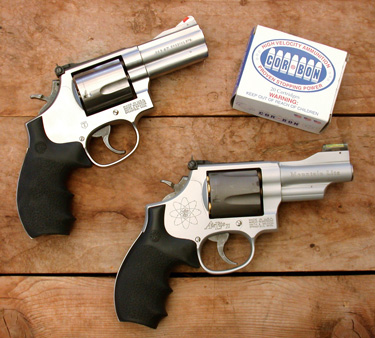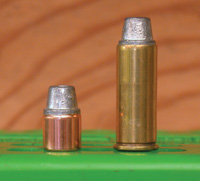
The Triple Lock, perhaps the finest double-action revolver ever produced, had a very short life span, lasting only until 1915 with just over 15,000 being manufactured. They sold for $21 at a time when one dollar was a lot of money, but because of an attempt to save $2 on its price, the Triple Lock died. True!
It was replaced by the .44 Hand Ejector 2nd Model, which lacked the third lock, a shortcut that allowed it to retail for $2 less than the Triple Lock. To add insult to injury, the Triple Lock’s shrouded ejector rod housing was also dropped. The result was simply a larger Military & Police.
More 2nd Models were built than 1st Models, about 2,000 more, but it would take 35 years to accomplish. Both the Triple Lock and the 2nd Model are rarely, very rarely, found in other chamberings such as .45 Colt, .44-40, and .38-40; however they were first and foremost .44 Specials. As soon as the Triple Lock was replaced by the 2nd Model, sixgun connoisseurs began calling for a return to the Triple Lock. As so often happens with gun companies, the pleas for the return to what a double-action sixgun should be fell on deaf ears, at least until 1926.

What individual shooters could not do, Wolf and Klar, a gun dealer in Fort Worth, Texas, could do. An order was placed with Smith & Wesson for several thousand revolvers chambered in .44 Special with the enclosed ejector rod housing. Except for the missing third lock, these revolvers were every bit as good as the 1st Models and were eagerly accepted by shooters and especially by Southwestern lawmen.
The 4″, fixed sighted, double-action .44 Special Smith & Wesson was just about the perfect defensive sixgun in the 1920s, and there is some doubt that it has ever been pushed to second place. This 3rd Model, also known as the Model 1926, would be produced until the start of World War II, when all production of civilian arms ceased, and then resurrected in 1946 for only a short time until the next model appeared.
As great as the Model 1926 was, it did not replace the 2nd Model as both were produced simultaneously until the eve of World War II.
The Model 1926 is even more rare than the Triple Lock, with only about 6,500 being produced in the two runs from 1926 to 1941 and 1946 to 1949. Just as with the 1st and 2nd Models, this 3rd Model was offered in both fixed-sight and target-sight versions. By 1949, the Model 1926 was about to be changed to become the 4th Model Hand Ejector of 1950. The Model 1950 was offered in two versions: the rare fixed-sight Military Model with only about 1,200 being produced, and the magnificent 1950 Target Model.
Both were offered in barrel lengths of 4″, 5″, and 6-1/2″ with the 4″ 1950 Target being rare and the 5″ Target extremely so. Just under 5,100 4th Model Target .44 Specials were made from 1950 to 1966. In 1957, when all Smith & Wessons lost their personality and became mere model numbers, the 4th Model Military Eight years later I actually came upon a 6-1/2″ Model 1950 Target. I had placed a Winchester 1886 on layaway at the Gunhaus and when George called me to tell me about the Smith & Wesson, I backed off the Winchester and took the 1950 Target instead.

Then I did it again! I wanted the 6-1/2″ 1950 Target, but I also wanted a 4″ version even more and had the barrel shortened to four inches. Strike Two! Fortunately, thanks to regular readers of Guns and American Handgunner, I have been contacted about .44 Special Smith & Wesson sixguns for sale and in recent years have purchased three 4″ .44 Specials, a 1926 Model made the same year I was, a 1950 Military, and a 1950 Target, as well as a 6-1/2″ Model 1950 Target. There will be no Strike Three and the sixguns will be enjoyed exactly as the beautiful works of art they really are.
Not only was the 1950 Target a magnificent sixgun in its own right, it became the basic platform for the .44 Magnum. In 1954 Smith & Wesson began experimenting with a new Magnum in a 4″ 1950 Target with special heat-treating and the cylinder re-chambered to the longer .44.
When the .44 Magnum became reality, it was a 1950 Target with a longer cylinder, bull barrel, high polish Bright Blue finish, and adjustable sights consisting of a white outline rear sight and a front ramp sight with a red insert. The 1950 Target with its special heat-treating could handle the .44 Magnum, but shooters could not, and an extra half-pound was added to the weight by going to the longer cylinder and bull barrel.
The coming of the .44 Magnum pushed the .44 Special aside very quickly. Some shooters, such as sheriff of Deaf Smith County Texas, Skeeter Skelton, sold his 4″ 1950 Target .44 Special and replaced it with a 4″ .44 Magnum, only to find it was a lot harder to pack all day and the ammunition was much too powerful for law enforcement use. Of course, a handloader could tailor-make .44 Magnum ammunition at the .44 Special level, but if one is going to shoot .44 Special ammunition, why carry the heavier sixgun? Skeeter admitted he was sorry he ever sold his .44 Special.
In 1966 Smith & Wesson dropped the 1950 Target/Model 24 from production. Of course, as always happens, when something disappears a demand appears. It would be Skeeter Skelton who would help keep the fire burning for .44 Specials by publishing an article in the early 1970s about converting the Smith & Wesson .357 Magnum Highway Patrolman to .44 Special. In those days Smith & Wesson .44 Special barrels were still available so it was simply a matter of re-chambering the .357 cylinder to .44 Special and fitting a new barrel.

It would take a while, but finally in 1983 Smith & Wesson brought back the .44 Special as the Model 24-3. To ensure selling all of these guns they promised to make only so many. They were offered in both 4″ and 6-1/2″ versions with a production run of one year and 7,500 being produced. They sold quickly; in fact the demand for these resurrected .44 Specials was greater than the number produced. Now what?
Smith & Wesson had backed themselves into a corner by promising only to produce a certain number, and yet the market was out there for more .44 Specials. This dilemma was solved by offering the stainless-steel version, the Model 624, with the same barrel lengths from 1985 to 1987. Both the blued 24-3 and stainless-steel 624 .44 Specials were also specially ordered and offered as 3″ round-butted versions by Smith and Wesson distributors.
The Smith & Wesson .44 Special died in 1966, was resurrected in 1983, and died again in 1987. However, the .44 Special is too good to stay buried for very long. In 1996, the Smith & Wesson .44 Special returned as the Model 696, a stainless steel, five-shot L-frame with a 3″ barrel and round butt grip frame. It was followed by the Model 396Ti, the same basic revolver with an alloy frame and titanium cylinder.
And then after nearly 20 years we got back to basics with a full-sized, six-shot, N-frame .44 Special: the Model 21-3, a 4″ round–butted, fixed-sight, blue steel revolver with an enclosed ejector rod. It first appeared as the Thunder Ranch Special and now is a standard catalog item.
Smith & Wesson also produces two 4″ .44 Magnums, the Model 29 Mountain Gun with the tapered barrel of the 1950 Model and the 26-oz. scandium/titanium 329PD. If the truth be known, both of these Magnums are better suited to .44 Special use. Just this past year S&W introduced, or I should say re-introduced, the Model 1950 Target as the Model 24-6 Classic with the same 6-1/2″ barrel length as the original. The .44 Special is definitely alive and well at Smith & Wesson.
Click Here to Read Part 3
Click Here to Read Part 1

Next Step: Get your FREE Printable Target Pack
Enhance your shooting precision with our 62 MOA Targets, perfect for rifles and handguns. Crafted in collaboration with Storm Tactical for accuracy and versatility.
Subscribe to the Gun Digest email newsletter and get your downloadable target pack sent straight to your inbox. Stay updated with the latest firearms info in the industry.

![Best Concealed Carry Guns In 2025 [Field Tested] Wilson Combat EDC X9S 1](https://gundigest.com/wp-content/uploads/Wilson-Combat-EDC-X9S-1-324x160.jpg)


![Best 9mm Carbine: Affordable PCCs [Tested] Ruger Carbine Shooting](https://gundigest.com/wp-content/uploads/Ruger-Carbine-Shooting-100x70.jpg)
![Best AR-15: Top Options Available Today [Field Tested] Harrington and Richardson PSA XM177E2 feature](https://gundigest.com/wp-content/uploads/Harrington-and-Richardson-PSA-XM177E2-feature-100x70.jpg)
